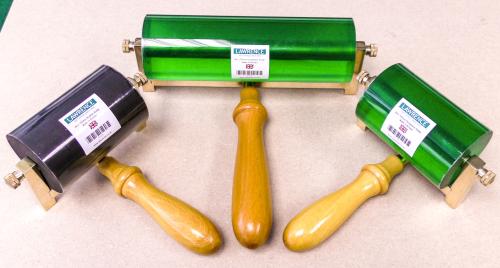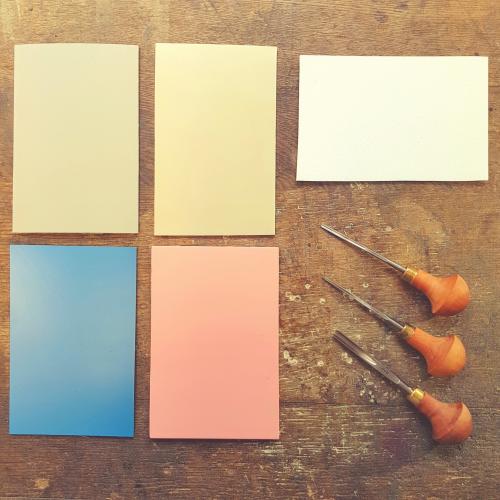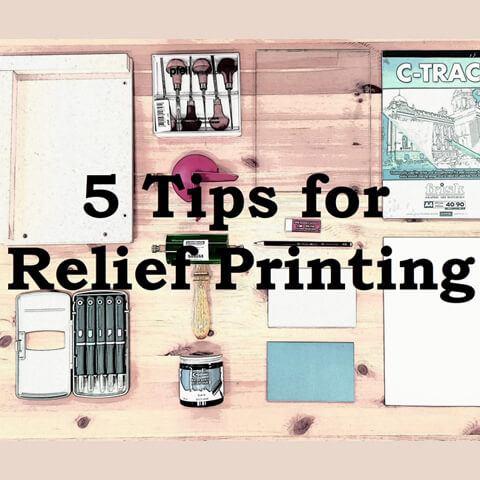Testing and Comparing Japanese Printmaking Papers
Testing and Comparing Japanese Printmaking Papers

Traditional Japanese papers - otherwise called washi (wa - Japanese, shi - paper) - are well known to printmakers. They are usually thin and extremely strong which makes them perfect for hand printing without a press. They come in a variety of shades, textures and fibrousness - no two papers are the same. Those that print on Japanese papers usually have their favourites or use different papers for different projects. The results are going to be unique, with a handmade feel.
Customers often ask us to recommend specific papers or to describe what they look and feel like so it was time to create a visual guide to Japanese papers.
In this blog post I am taking apart one of our Japanese sample books which you can purchase here. This little booklet is a perfect reference book for all the different Japanese papers we offer. It's pocket-sized and flippable so you can keep it at hand for planning your next project. The sample book currently contains 27 different papers we sell in sheets or rolls. This number changes as we add new papers and remove discontinued ones. The booklet comes with a handy list that translates the printed product codes to paper names - and some extra information about size and weight.

I have created a simple design that I can quickly carve and print onto the individual samples to show you what each looks like. I then grouped the papers together into smaller batches to explore the similarities and differences and give you a better idea of which one to choose.
Preparation
I started by separating the Japanese Sample Book by unscrewing the eyelet in the back. I took out the papers and put them on the side.
Then I cut a piece of Japanese Vinyl to 10 x 10cm size which is the approximate size of the paper samples. I had already prepared a small drawing of a Japanese cherry blossom branch - at the time of writing we are very much ready for spring to arrive - so I transferred over the design to the vinyl and started cutting it.
If you are curious, I used the following tools for this very small scale: Pfeil 12/1 V tool, 9/5 and 8/7 U gouges. The small tools allowed me to get to the small detail whilst the large gouge helped me remove the background.
Then I prepared the inking station with a glass inking slab, Speedball Watersoluble Black ink, an Essdee roller and a Lawrence Ball Bearing Baren. Read this blog post if you want to know more about this baren.
Printing the Design

The next step was to print my design onto all 27 sheets using the baren. I enjoyed the process most with the thinner papers because I could see the ink through the paper which told me exactly when to stop. Japanese papers are generally well-absorbing so I didn't have to use a whole lot of force. However, the thicker the paper, the more ink was needed for an even transfer. I laid out each piece on a side table and left everything to dry for a couple of hours. That's exactly why I like using water-soluble ink (other than the easy cleanup): it dries quickly so I can move onto the next step.
When everything was dry I sorted the papers by thickness and colour. The following sections will display the results on a split black and white background to show the colour and the transparency of each paper.
Tissues and Other Thin Papers
The first batch of papers are between 12 and 24gsm which make them the most translucent of the bunch. As you can see the flowers look sharp over both backgrounds and their fibrous textures really shine over the black paper. This makes tissues ideal for mounting on a colour background, using them in collages and for various other projects.

Tengujo (12gsm), Imitation No.3 (21gsm) & Kizuki 4 Monme (24gsm)
The next batch is made up of two handmade tissues (Kawanaka and Mulberry) and machine-made Yuki which is a heavier and less translucent paper with the same fibrous look to it. Yuki has two different sides which is quite common with Japanese papers. One side is textured and absorbent (which is what I chose to print on), the other is smooth and it has long shiny fibres running through it on both sides (see side image). The smooth coating on the back acts as a moisture barrier so the ink doesn't bleed. This side tends to be particularly suitable for printing onto.
The other two papers have a beautiful laid texture. Kawanaka has a soft ivory colour and Mulberry looks delicately checkered.

Kawanaka (29gsm), Mulberry Tissue TP2 (25gsm) & Yuki (75gsm)
More Thin, Translucent Papers
This category contains the most papers as Japanese papers tend to be thin: between 30 and 90gsm. The lower the weight, more more translucent the paper is. Anything below 60-70 gsm will have some see-throughness to it.
Sunome Senaka is a big favourite with a laid texture on one side and a smooth sheen on the other. It's high white in colour and when placed on a dark background, you can see the ribbing come through beautifully. Kozo Natural has a natural (but not cream) colour and Pure Phite silk is a soft white, and they both have a smooth and a slightly rouch textured side.

Sunome Senaka (62gsm), Kozo Natural Select (46gsm) & Pure White Silk (62gsm)
The next batch has three very similar papers with a more solid colour and less translucency. Bright white Hosho and softer white Masa, similarly to the previous batch, has 2 different sides. On the other hand Iyo Masashi is textured on both sides and feels like a sheet of felt, a very exquisite and relatively new paper. Hosho and Masa are great for students because of their large sheet sizes and economical prices. All three are machine made.

Hosho (77gsm), Iyo Masashi (62gsm) & Masa (86gsm)
Hosho Select is another printmaker's favourite, particularly for woodblock printing. It has a white colour and laid texture with a smooth, matt back side. The other two papers are off-white and slightly textured, with a surface similar to cartridge paper. Their backs feature a shinier smooth texture. Fun fact: Shiramine is also suitable for painting and pastel drawing and because it's on a roll, it can be cut to the size you need for each project. Okawara Student is a highly versatile paper for students and seasoned artists alike.

Hosho Select (80gsm), Okawara Student (51gsm & Shiramine Roll (70gsm)
Next up are three machine made papers in soft white, with Bunkoshi being the most natural ecru colour. Imitation Japanese Vellum comes in two thicknesses and they were created to imitate traditional Japanese papers for the European market. Both sides are smooth and it's incredibly sturdy which makes this paper ideal for not just printmaking but calligraphy, drawing and many more techniques. Okawara Select has a subtle texture and a smooth back side and it's used by students internationally because of its low pricepoint. Bunkoshi is traditionally Japanese looking with a smooth texture on both sides and 4 deckle edges.

Japanese Vellum Thin (130gsm), Okawara Select (51gsm) & Bunkoshi Select (70gsm)
Tinted Papers
Tinted papers are great if you are looking for a warm, natural colour for your print. The next 4 papers (Sekishu and the Kitakatas) really pop out from the rest. The handmade Sekishu (to right) is the thinnest and it is very translucent with a lovely fibrous texture on the front and a smooth back. Kitakata comes in 3 versions. Kitakata and Kitakata Green are both very thin (only 36gsm) and their texture is tightly ribbed. Kitakata is a deep natural cream whereas Kitakata Green has an olive tint to it. They both look absolutely gorgeous printed on. The third Kitakata (Select) is different from the others. It's heavy, opaque and smooth with subtle fibrousness.

Sekishu (34gsm), Kitakata (36gsm), Kitakata Select (90gsm) & Kitakata Green (36gsm)
The Thickest Papers
I left the thickest papers for last. They are all above 100gsm which makes them slightly more work to handprint on (you can see the prints are patchy at places) but a joy to use with a press. The colours range from high white (Bamboo Select, Bamboo and Hakuho) to soft white (Shiramine Select, Imitation Japanese Vellum Thick). They all have a similar cartridge paper-like surface except for the smooth Vellum. Shiramine Select has an especially lovely texture (to right).

Bamboo Select (170gsm), Shiramine Select (110gsm), Japanese Vellum Thick (225gsm), Hakuho Select (220gsm) & Bamboo (170gsm)
To Wrap Up
I hope you enjoyed this showcase of Japanese papers and that it got you thinking of potential new projects. To wrap it all up, I include a picture of all the papers laid out on a table, because it's great for comparison. So many different shades of white and cream! Look below for a list of all the papers and links to our website. I encourage you to recreate this project at home with your own design and see for yourself how the papers perform. It's great fun and a resource you will be able to go back to. You can purchase our Japanese Sample Book here.

Top Row (from left to right)
2231 - Imitation Japanese Vellum No 3 - 76 x 51cm - 21gsm
2342 - Bamboo - 76 x 56cm - 170gsm
2321 - Kitakata Green - 52 x 43cm - 36gsm
2324 - Hosho Select - 52 x 43cm - 80gsm
2325 - Bamboo Select - 52 x 43cm - 170gsm
2323 - Kitakata Select - 52 x 43cm - 90gsm
2326 - Shiramine Select - 52 x 43cm - 110gsm
2328 - Okawara Select - 52 x 43cm - 51gsm
2327 - Kozo Natural Select - 52 x 43cm - 46gsm
Middle Row
2331 - Bunkoshi Select - 52 x 43cm - 70gsm
2329 - Hahuko Select - 52 x 43cm - 70gsm
2344 - Masa - 79 x 53cm - 86gsm
2661 - Mulberry Tissue - 55 x 48cm - 25gsm
2302 - Tengujo - 63 x 94cm - 12gsm
2314 - Kawanaka - 60 x 91cm - 29gsm
2340 - Hosho - 79 x 55cm - 77gsm
2470 - Sunome Senaka - 109 x 79cm - 62gsm
2410 - Sekishu - 99 x 61cm - 34gsm
Bottom Row
2236 - Japanese Vellum Thick - 64 x 48cm - 225gsm
2235 - Japanese Vellum Thin - 64 x 48cm - 130cm
2347 - Kitakata - 52 x 43cm - 36gsm
2341 - Kizuki 4 Monme - 97 x 64cm - 24gsm
2970 - Yuki - 64 x 94cm - 75gsm
24681 - Okawara Student - 45 x 64cm -51gsm
2367 - Pure White Silk - 100 x 66cm - 62gsm
2345 - Shiramine Roll - 97 x 200cm - 70gsm
2392 - Iyo Masashi - 38 x 52cm - 62gsm
As always, feel free to email us with any questions at artbox@lawrence.co.uk.













